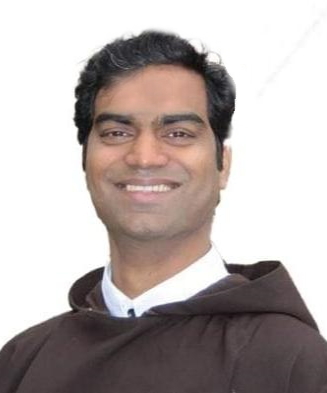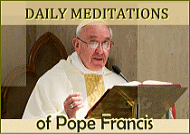“In three days I will raise it up.”
(Gospel Reading – Jn 2:13-25)
As we may well be aware, the Liturgy of the Word for Sundays in the Catholic liturgy is laid out in a three-year cycle. During Lent, the Year A cycle uses the Gospel of John, with passages particularly relevant for those who are preparing for baptism during Easter. This year, we are using the Year B cycle, basically reading from the Gospel of Mark. Previous two Sundays of Lent we read from the Gospel according to Mark. But today we switch over to John and continue listening to John until the 5th Sunday in Lent. The Gospel of John is often considered the most difficult of the Gospels – highly symbolic in its expression and deeply theological in its content. John likes to use terms with more than one meaning and thus invite us to a deeper level of reflection. The gospel text of today focuses on the temple. Without denying the historicity of the event described in the reading of today, I would like to offer a symbolic interpretation of the temple itself.
The temple as a symbol of our Christian life
The temple of Jerusalem was built on a mount. It had different courts, at different elevations, which led finally to the most important part of the temple. The Outer Court was at the lowest level on the temple mount. It was not part of the temple as such and was sometimes referred to as the Court of the Gentiles. Into this court anyone could enter. There was much social life in this court, with a lot of business. Besides food and other luxuries for the pilgrims, there was a lot of activity in exchanging money – to change the Roman coins into the temple shekel for the offerings, and buy and selling of animals and birds for sacrifice. Perhaps, it was this area that Jesus was trying to cleanse. But Jesus insists that even this outer court is part of the temple and hence a house of prayer, furthermore in Mark (11:17) Jesus quotes Isaiah (56:7) reiterating the universality of the temple: “My house will be called a house of prayer for all peoples?”
From the Outer Court there was the entrance to the Court of Women, and then to the Court of the Israelites. We suppose, in these courts there was fellowship. The Jews sang sacred songs, the psalms, and danced. There were prayer elements in the activities, but also a lot of social activity. Perhaps it is here that the rabbis sat in different corners and taught. Jesus was also found teaching in the temple (Jn 7:14, 28; 8:20), and he did this probably in this area. Sure enough, here there was much more serious activity than the hustle and bustle of the Outer Court.
Deeper into the temple, at the fourth level, was the Court of the Priests. Here there were three focal points, each with its specific purpose. There were the lavers meant for incense; these were in two sets of five each on either side. There was the “Brazen Sea” where the blood of the animals was poured in libation. Finally, there was the altar where the sacrifice was offered. As we can see, this was yet a deeper form of relating to God than just fellowship. This was the place of worship. On the sides of this court there were the cubicles of the priests where the priests would prepare themselves for the services.
Still further in, there was the Holy of Holies. The Holy of Holies housed the tabernacle, which was the arc of the covenant that contained the tablets of the Ten Commandments. Only the High Priest could enter the Holy of Holies, and that too only once a year. There was a black curtain that hid the Holy of Holies from view of the public. No one could ever see God face to face! For the Jews, the tabernacle meant the presence of God-Yahweh. So no one could see the tabernacle face to face.
It is not by chance that the Psalmists sing of the glories of the temple, particularly expressing their yearning to be in the Holy of Holies – to commune with the Lord God. For instance, Psalm 84 expresses that deep longing of the Jew. I paraphrase here Ps 84:3: even the sparrow can fly into the Holy of Holies but I cannot! And elsewhere in the same Psalm: “One day within your courts is better than a thousand elsewhere” (v.10). Many of the pilgrim psalms (Ps 102, 116, 122), express powerfully the inner thirst of the believer to be in the presence of God who is enshrined in the temple.
I see these layers of the temple as possible stages in our own Christian life journey. God in Jesus makes it possible for us to commune with Him – to enter the Holy of Holies! But are we stuck somewhere in the other courts?
Jesus, the Holy of Holies
All the gospels speak about cleansing in the temple (Mt 21:12-16; Mk 11:11, 15-17; Lk 19:45-46; Jn 2:14-16). In the synoptic Gospels this event comes towards the end of Jesus’ public ministry. But in John it is at his first visit to Jerusalem during his public ministry. (He would make three visits). In Mt and Lk it is a little bit too sudden and unprepared; in Mark, Jesus’ response is more considered. He goes to the temple and sees what is happening (Mk 11:11), goes back to Bethany for the evening, and on the next day the cleansing follows. In Jn 2:13-21: in the act of cleansing the temple and the debate that ensued between Jesus and the leaders of the temple, Jesus offers a new interpretation of the temple: that, He is the new temple!
When Jesus was hanging on the cross about to breathe his last, “there was darkness over the whole land until the ninth hour, while the sun’s light failed; and the curtain of the temple was torn in two” (Lk 23:44-45, RSV). This event describes a moment of revelation in the history of salvation: God is not hidden any more in the dark corner of the temple but hangs on the cross outside the city walls. There is no more secrecy about the Holy of Holies where only the high priest could enter. Because of the passion, death and resurrection of Jesus – the paschal mystery – everyone who believes in Jesus has access to the Holy of Holies. The ‘hour’ has now come (Jn 13:1).
On this third Sunday in Lent, a question that we could be asking ourselves is, are we ready to take the plunge? Are we willing to open ourselves to that Grace to commune with God? Now, how could we take the plunge? Surely, a whole-hearted participation in the Eucharistic celebration is a privileged possibility. Contemplating on the Word of God, as individuals and communities, is another possibility.
Fr. Franco Pereira, S.D.B.


